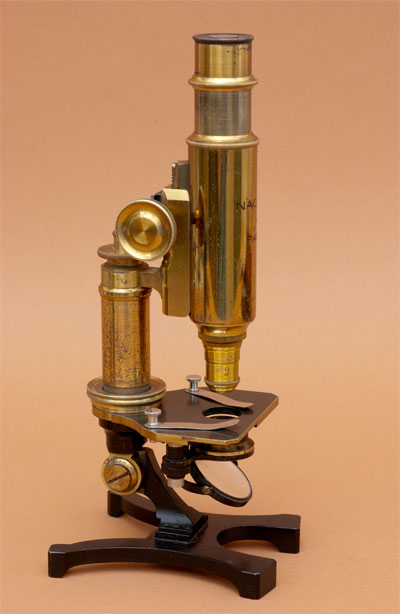 |
|||||
 |
 |
||||
 |
|||||
 |
 |
||||

This microscope is a rare portable microscope by Alfred and Albert Nachet of Paris. The instrument can be either a compound or simple microscope by changing the attachment mounted to the folding base. For a simple magnifier a cantilevered arm can be pressed into the mount and either of two low magnification doublets added to the arm. As a compound microscope, the support pillar can be attached to the base and fixed with a threaded collar. Locating pins on the pillar assures alignment. There are three achromatic objectives for the compound microscope. They are embossed, "2", "3", or "6". There is only one Huygenian eyepiece (marked "2"). Imaging is very good, showing very little chromatic aberration, but low contrast.
Coarse focus is via a rack and pinion mechanism that moves the microscope body relative to the stage. Fine focus is via a screw mechanism that moves the body mounting section. Mechanically, the stage is fixed just above the base hinge. The stage is rectangular and has two chrome slide clips on top and a condenser mounted below. There is no optic in the condenser. The illuminating mirror is fixed to a support that descends fom the bottom of the stage. The microscope disassembles and can be stored in the original fruit wood case covered in blach shagreen and lined in purple velvet. The microscope body is signed on the tube “NACHET à PARIS”, and on the padding in the lid of the box “NACHET & FILS, 17 RUE ST, SEVERIN, PARIS”. The microscope is approximately 26cm tall.
This model was illustrated for the first time in the 1898 Nachet catalogue. The present example has an older style of knurling on the tube than in the 1898 engraving. In the 1892 catalogue this model is still offered without the coarse focusing by means of rack and pinion. The Nachet optical company was founded by Camille Nachet in 1840. His son Alfred (1831-1908) followed by his grandson Albert (1863-1930) continued the company well into the 20th Century.
Microscope featured 12/2015